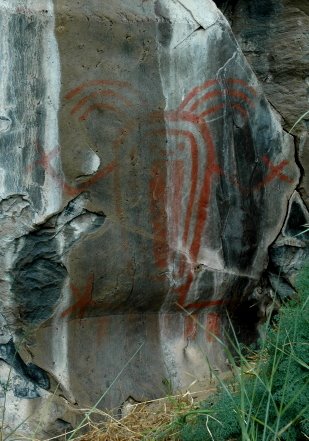 Clovis first?...Clovis second?...or maybe not Clovis at all?
Clovis first?...Clovis second?...or maybe not Clovis at all?Research and discoveries that directly impact our thinking on when the Americas were first populated is accelerating.
News from Oregon (that's Paisley Cave to the left), Texas, Mexico and elsewhere is pushing back the earliest dates and expanding the routes of first peopling.
My personal opinion is that we're only at the beginning of understanding how and when the first people arrived in North and South America.
I've been around science long enough to have learned that, whatever the topic, the popular scientific theories of the day usually turn out to be too simplistic to explain reality. The world is a complex and messy place that often can't be reduced to a single neat answer...but that's OK! Its the process of advancing theories and facts that push our understanding forward.
So it appears that the original theories of a single land bridge migration into North America aren't the whole answer. Check out the interesting videos and articles on the topic below...and see what you think!
Migrating to North America
 Here's a fascinating video about Paisley Cave, Oregon and the discoveries there. Click on the image to the left or on the link below to watch...
Here's a fascinating video about Paisley Cave, Oregon and the discoveries there. Click on the image to the left or on the link below to watch...Click here for Paisley Cave video
Professor Dennis Jenkins (pictured below), who leads the project at Paisley Cave where evidence of human occupation as much as 14,000 years ago has been discovered, has prepared a fascinating overview that you can read by clicking here.


Researchers at Paisley Cave wear body suits to
eliminate potential contamination of DNA samples.
Skull in Underwater Cave May Be Earliest Trace of First Americans
National Geographic
February 18, 2011
By Fabio Esteban Amador
 Explorers have discovered what might be the oldest evidence of humans in the Americas. Alex Alvarez, Franco Attolini, and Alberto (Beto) Nava are members of PET (Projecto Espeleológico de Tulum), an organization that specializes in the exploration and survey of underwater caves on the Yucatan Peninsula in Mexico. Alex, Franco and Beto have surveyed tens of thousands of feet of mazelike cave passages in the state of Quintana Roo. The team’s relatively recent explorations of a large pit named Hoyo Negro (Black Hole, in Spanish), deep within a flooded cave, resulted in their breathtaking and once-in-a-lifetime discovery of the remains of an Ice Age mastodon and a human skull at the very bottom of the black abyss...
Explorers have discovered what might be the oldest evidence of humans in the Americas. Alex Alvarez, Franco Attolini, and Alberto (Beto) Nava are members of PET (Projecto Espeleológico de Tulum), an organization that specializes in the exploration and survey of underwater caves on the Yucatan Peninsula in Mexico. Alex, Franco and Beto have surveyed tens of thousands of feet of mazelike cave passages in the state of Quintana Roo. The team’s relatively recent explorations of a large pit named Hoyo Negro (Black Hole, in Spanish), deep within a flooded cave, resulted in their breathtaking and once-in-a-lifetime discovery of the remains of an Ice Age mastodon and a human skull at the very bottom of the black abyss...Read the whole story by clicking on the photo or here.
 Spear Points Found in Texas Dial Back Arrival of Humans in America
Spear Points Found in Texas Dial Back Arrival of Humans in AmericaBy John Noble Wilford
New York Times Science
Published: March 24, 2011
For many years, scientists have thought that the first Americans came here from Asia 13,000 years ago, during the last ice age, probably by way of the Bering Strait. They were known as the Clovis people, after the town in New Mexico where their finely wrought spear points were first discovered in 1929.
But in more recent years, archaeologists have found more and more traces of even earlier people with a less refined technology inhabiting North America and spreading as far south as Chile.
And now clinching evidence in the mystery of the early peopling of America — Clovis or pre-Clovis? — for nearly all scientists appears to have turned up at a creek valley in the hill country of what is today Central Texas, 40 miles northwest of Austin...
Read the whole story by clicking the photo above or here.
Thanks to Russel Micnhimer, Robin Harrower, the New York Times, University of Oregon, and National Geographic for contributing some of the info used in this post.







No comments:
Post a Comment